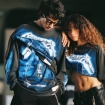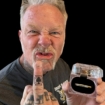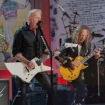It was a purposefully compatible and slightly more adventurous follow-up to their 1996 album Load, but Metallica's Reload didn't start out as its own self-contained record. When the band started recording Load at The Plant Studios in Sausalito, California in May 1995, the plan was to release a single album comprised of material from both albums.
The songs for Reload were already written and mostly arranged. As the deadline for the album approached, however, Metallica realized there was no way they were going to be able to finish everything. So they took the tracks that were already done and released them as Load on June 4, 1996. Following a tour to support the album, Metallica returned to the studio to finish the remaining tracks, which they released as Reload on November 18, 1997.
"Reload consisted of all the crappy songs [from the original session]," said James Hetfield in a 1997 interview. "That's the obvious thing to think for the non-thinkers out there. But really, those weren't the rejects, they were just all the songs that weren't finished. I think there's a little more extremeness on Reload. But there are also some big-time epic, heavy riffs. They're not pop singles, that's for sure."
Reload is hardly extreme by current metal standards, but it did give Metallica a canvas to explore different styles, including Southern rock, the gritty singer-songwriter fare of Tom Waits and Nick Cave and some fiery electric blues.
"After returning to these songs two years after we wrote them, we had some additional ideas of what we could do with them to make them better," Hetfield said. "We wanted to put them out without really adding any newer material to it. We kept it really pure to the Load sessions. But we wanted to come up with newer sounds. A lot of these had guitars already but sounded a little dull, so we got better sounds and re-recorded them."
Since the songs were almost done, it only took Metallica about three months to complete the album. On October 1, 1997, the basic tracks were all completed, then Reload underwent additional editing at Plantation Studios in Maui, Hawaii before it was mastered at Sterling Sound in New York. Like its predecessor, Reload topped the Billboard album chart in its first week of release, selling 436,000 copies. It was certified both platinum and double-platinum by the end of the year.
1. Reload's cover art was literally a photo of Piss and Blood — and James Hetfield hated it
The artwork for Reload was a sequel to the abstract flowing colors of Load. Like that album, the cover was a photograph of a mixed media blend from controversial New York artist Andres Serrano. The image for Load, originally called Blood and Sperm III, was made from cow blood and ejaculate pressed between sheets of Plexiglass; Reload depicted the photo of Piss and Blood, the composition of which is equally self-explanatory. Guitarist Kirk Hammett was a fan of the photographer; Hetfield – not so much.
"I hated it, but it had to match," he said. "It's matching hatred. I'm not a big fan of the man and his perversions. There's art and then there's just sick motherfuckers. And he's one of them. [Laughs] The thing is, they belong together. I don't care if the guy blows donkeys. The art had to match."
2. Metallica got Marianne Faithfull liquored up to record "The Memory Remains"
The first single from Reload was "The Memory Remains," which came out November 11, 1997. Two demos titled "Memory" were recorded in drummer Lars Ulrich's home studio on March 16 and 17, 1995. Since the mid-paced song was about a washed-up movie star, producer Bob Rock suggested the band have popular Sixties' English singer and actress Marianne Faithfull add guest vocals to the chorus, since her ragged whiskey and cigarette-worn tone would work with the theme of the song.
"We needed a real character, been-through-it-all voice," Hetfield said. "We got ahold of her and she agreed to do it. So, we flew to Dublin on the way to Belgium. We met up with her in the studio, went in and got her drunk and then she sang this bit. It was perfect. She definitely had the voice and it created a real eerie vibe."
Metallica performed the song with Faithful twice live. The first time was on Saturday Night Live on December 6, 1997, and she also joined them on December 7, 2011 at the Fillmore in San Francisco.
3. "Low Man's Lyric" was nearly a garden-variety metal ballad, until ex–Faith No More guitarist Jim Martin saved the song — with a hurdy-gurdy
One of the more interesting tracks on Reload is "Low Man's Lyric," which starts with effect-laden guitars playing a bluesy riff redolent of Jimmy Page. But what makes the song so alluring is a combination of Hetfield's vulnerable, raspy vocals and a carnival-esque arrangement. Highlighting the sound is a hurdy-gurdy, a stringed instrument that creates merry-go-round sounds when a hand-crank is turned and a spinning wheel rubs against the strings.
"I was going for this real broken-down homeless sound," Hetfield says. "I wanted it to be like random instruments found in an alleyway and some lyrics just kind of haggardly thrown in there. We had recorded that song already and it sounded like this big metal ballad. I convinced Lars to get rid of the booming drums and we searched for something else that would give the song a different feel. We're friends with [former Faith No More guitarist] Jim Martin and he had a hurdy-gurdy at home. I played around with it for a while and I loved the way it sounded. He said we could use it so we added it to the song. It totally gave everything a different feel that reminded me of Tom Waits."
4. While writing Reload, Metallica were excited by something Hetfield calls "helter-skelter" tension
Before the album came out, there were rumors that Reload would mark a return to Metallica's thrash roots — which didn't come until 2008's Death Magnetic. The fastest and heaviest song on Reload was "Fuel," but even that was a quantum descent in velocity from a track like "Blackened" from …And Justice For All.
"Fast thrash just wasn't exciting to us anymore, really," Hetfield said. "If I wrote it, then we'd use it, but none of us were writing that stuff. On 'Fuel' there was some pretty quick down-picking — just kind of moving around with root notes — but that's about it. It's was a little more exciting for us to figure out more fucked up chords — things that grind — dissonant bits. In a few of the songs there's helter-skelter tension built in there. That kind of stuff excited us more than the speed stuff."
5. Hetfield dealt with the struggle between aging gracefully and acting like a maniac — by getting chased by cops
The Reload era triggered in Hetfield a rediscovery of his working-class roots. Sure, he had enough money to live the high life, but for a while at least, he preferred to drink hard, work on his vintage muscle cars, go hunting and get in a little bit of trouble with Johnny Law.
"I think I had more of that adult confidence, but some more childish actions," he said. "Getting an old '55 Chevy and working on it to turn it into a hot-rod to make the cops chase me — shit like that became exciting to me. I never did that as a kid. Cops chased me doing other things, but some of the shit that I missed out on as a youth I started getting into. We started Metallica when we were young and it made us pass up a few things while we were busy touring and being responsible. So, in a way, we became more irresponsible."








